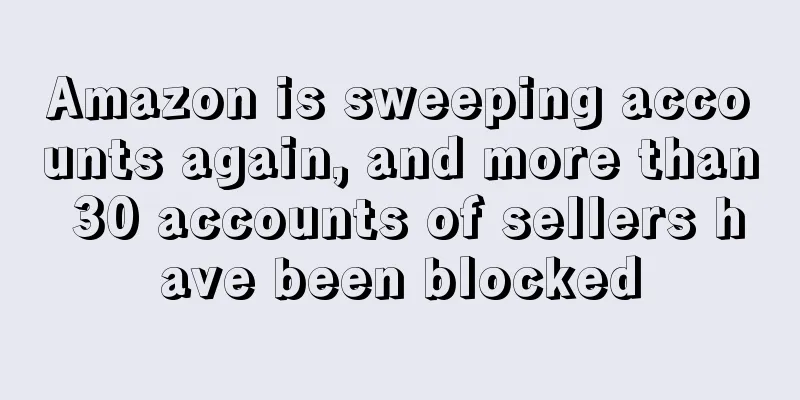Amazon is sweeping accounts again, and more than 30 accounts of sellers have been blocked

|
Another wave of Amazon number sweeps is coming.
This wave of account scanning targets brand associations. If there is a problem with one of the multiple stores authorized by the brand, the other stores will be implicated, and a batch of seller accounts will be blocked as a result.
In addition, brands complained that follow-selling was judged to be abusive , and a large number of sellers' brands were removed. Recently, follow-selling has become more rampant, and the number of disputes caused by follow-selling has increased. Brand sellers and follow-selling have started to curse each other online, and professional follow-selling has even live-streamed online to recruit apprentices. Brand association leads to account suspension , and a large number of sellers are affected
Recently, another round of account sweeps broke out on Amazon, and a number of sellers' accounts were blocked. The reason for the attack was that brand authorization triggered associations. Some sellers had more than 30 accounts shut down, and some sellers had a single store or several stores closed.
A seller said that the old account and the new account use the same brand, which is registered in the old account and authorized to the new account. Because of some illegal operations, the new account was shut down by the platform last year. After the new account had problems, the old account revoked the brand authorization. Now the old account is also shut down. The seller suspects that the brand authorization caused Amazon to scan the account.
In fact, the situation of the above-mentioned sellers is not an isolated case. According to an industry service provider, many sellers have recently encountered Amazon account scanning due to account association caused by brand authorization. The number of accounts scanned this time may be as high as tens of thousands.
Amazon provides brand sellers with many brand operation and promotion tools, which can help sellers advance business development faster and promote sales growth. For licensees, they can use brands to make their products known to consumers in a timely manner. The same product, combined with brands, can bring higher prices and higher sales, thereby bringing more profits.
Therefore, some Amazon sellers do brand authorization and use multiple accounts to sell one brand. Once an account has violated the rules, the brand will be affected.
Brand violations can easily lead to problems. Recently, brand complaints about follow-selling have been judged as abuse, and a large number of sellers’ brands have been removed.
Amazon judged that the company abused its brand by trying to copy and sell products
Amazon sellers will not only lose sales if they encounter copycat sellers, but also suffer from accidental losses due to the fact that some copycat sellers do not strictly control the quality. Therefore, sellers will use various methods to drive away copycat sellers. However, there are many crises in driving away copycat sellers.
Some sellers have fallen into the crisis of brand abuse because of following others. Many peers have reported that they have recently failed to file a complaint against following others, but were instead judged to be brand abuse, with the brand removed, the link split, and no editing rights, so they can do nothing.
In fact, Amazon does not punish sellers who receive complaints, but the sellers themselves have problems with their brands.
It is understood that when a seller complains about copycat sales, Amazon will first verify the identities of "both parties" to determine whether the seller is the brand holder or authorized person. During the verification process, Amazon will also review various information of the brand, including the "registered trademark lawyer". During the investigation, it was found that the seller's brand or trademark registration lawyer was "illegal".
In addition to the lawyer issue, many sellers do not understand the purpose of each brand tool, and use the tools to catch copycat sales, or find some service providers to catch copycat sales. Improper operation of the service providers leads to the brand being deemed abuse by Amazon.
Some sellers sought help from service providers to stop copycat sales and received violation warnings from Amazon. The platform determined that the violation was caused by sellers attempting to interfere with other sellers’ product information, ratings, feedback or reviews.
Therefore, the sellers at this time not only fail to catch up with the copycat sales, but also shoot themselves in the foot, causing their own brands to be judged as abused.
During this process, many sellers are unaware that there are problems with their own brands, or they have encountered unreliable service providers. So even though they are clearly victims, they are judged to be wrong by the platform and feel particularly aggrieved. It is already sad enough to be followed by others, and when they complain about follow-selling, the brand is instead judged to be abused, and the sadness is instantly magnified.
One seller said that because he failed to file a complaint with the TM mark, he went to the service provider to remove the follower sales, but was complained by the follower sales. Amazon determined that he had damaged the interests of the follower sales and blocked the seller's account. As a result, the account did not file a complaint, and the seller lost hundreds of thousands of yuan. The seller further said that many people have removed the dead accounts of follower sales, and this statement has also been recognized by other peers.
In this regard, some sellers in the industry have questioned: "Can we still list our products in light of this wave of brand abuse by Amazon?"
The follow-up sellers and the boutique sellers quarreled online
Now that the news that following others may lead to account closure or brand abuse has been released, many sellers say they dare not file a complaint against following others. Following others seems to be even more rampant.
Recently, Amazon's follow-selling has triggered a war of words online. An Amazon boutique seller found that many of his peers were followed by others this year and could not be driven away. In addition, he had a product with the R mark, but had not taken any protective measures, so it was followed by others as soon as the traffic increased. So this seller angrily denounced the follow-selling online and made the other party's information public.
This move triggered a counterattack from the follower, who shouted on the Internet: If he dares to complain about the follower, his brand will be abused until Amazon deletes the brand.
The attitude of following sellers is arrogant, and many sellers have found that there are a lot of following sellers in recent times. Some people have found that some institutions have used live broadcasts to teach everyone how to follow FBA, with teaching prices ranging from 16888 to 26888.
Searching for Amazon follow-selling live on a social software, I found a lot of this kind of content. Some accounts are dedicated to teaching people how to follow-sell on Amazon, and they also advocate the FBM follow-selling method of software, luring people to buy their software at high prices. The leeks-cutting behavior of these institutions has also increased the number of follow-selling.
The professional followers of these organizations even threatened that if anyone complained about them, they would continue to abuse the brand. They would follow the sales 24 hours a day and claimed that nothing could be done to them except for the Transparency Plan!
Hijacking is a business model that Amazon allows , but some hijackers break the rules. For sellers, being hijacked not only leads to losing traffic and orders, but also leads to bad reviews due to non-delivery or mismatched goods. As a result, the links that sellers spent money and time to promote are useless, and some sellers even suffer heavy losses due to malicious hijacking. Sellers hate malicious hijacking.
Many industry insiders believe that the platform's practices have also provided fertile ground for malicious follow-selling. Brand sellers who complain about follow-selling will be judged as brand abuse, and everyone is miserable. One seller was helpless: "There is no other good way except to do a transparent plan. It is best to apply for it before shipping new products, and then ship them after labeling."
With the peak season approaching, sellers’ accounts and brands are crucial, so everyone must protect themselves. Amazon Scan number Account blocked |
<<: Consumers take Amazon to court for not getting refunds on returns!
Recommend
What is 4Middleware? 4Middleware Review, Features
<span data-docs-delta="[[20,{"gallery"...
What is TUK? TUK Review, Features
TUK is a trendy shoe brand that was born in the UK...
Revenues soared 240 times as spring and summer travel products are hot on Amazon
Since the outbreak of the epidemic, people's ...
The global online market is expected to grow 15% per year
According to a report by OC&C Strategy Consul...
Amazon's new round of account sweeps! A large number of sellers suffer
Amazon has been cracking down on accounts more an...
Unable to beat Temu, the "king of volume"! Another US retailer collapses
In modern society, people's consumption has g...
What is Skubana
Skubana can help Amazon sellers manage all back-e...
Top 10 Russian search products in 2021 released
Avito is the most popular classified advertising ...
New service coming? Amazon says it is testing
Recently, foreign media reported that Amazon is p...
What is Purple Bird Data Cube
Ziniao Data Cube is a multi-functional Amazon sel...
What is Wantdo? Wantdo Review, Features
Wantdo is an outdoor sportswear brand launched by ...
What is BangBoom? BangBoom Review, Features
BangBoom is a one-stop solution service provider f...
What is CNE (Diyi International Logistics Co., Ltd.)? CNE (Diyi International Logistics Co., Ltd.) Review, Features
CNE International Logistics Co., Ltd. (registered...
What is Cross-border Knowledge? Cross-border Knowledge Review, Features
Cross-border Know is a cross-border information a...
What is ReviewEasy? ReviewEasyReview, Features
Pingpingyi was founded in 2013. It is an Amazon re...









